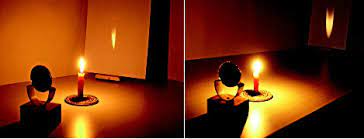Table of Contents
Activity 11.7- Forming Images with a Concave Mirror
Objective- To observe how a concave mirror forms different types of images of a candle flame at various distances, demonstrating real and virtual image formation.
Materials Needed-
- A concave mirror (a mirror that curves inward like a bowl).
- A candle.
- Matches or a lighter.
- A screen or a wall (for projecting real images).
Procedure-

- Light the Candle- Place the candle on a table and light it. Be careful with the flame.
- Close-Up Observation- Start with the candle close to the concave mirror, within the focal length (the distance between the mirror and its focal point). Observe the image.
- Move the Candle Back- Gradually move the candle away from the mirror. Notice how the image changes at different distances – from within the focal length, at the focal length, and beyond it.
- Use the Screen- When the candle is beyond the focal length, try projecting the image on a screen.
Also Check – Class 7 Science -Chapter 15 – Light- Complete Notes
Also Check – Chapter 11- A Detailed Guide to the Light Activities for Class 7 Students
Core Concepts Explained-
- Concave Mirrors and Image Formation- Concave mirrors can form different types of images depending on the distance of the object from the mirror.
- Real Images-
- Formed when the object is beyond the focal length of the mirror.
- These images can be projected on a screen.
- They are inverted (upside down) and can vary in size.
- Virtual Images-
- Formed when the object is within the focal length of the mirror.
- These images cannot be projected on a screen; they seem to be behind the mirror.
- They are erect (upright) and larger than the object.
Possible Questions and Answers-
Why does the image change when I move the candle?
- The distance of the candle from the mirror affects how light rays are reflected. Different positions create different types of images.
Why is the image bigger when the candle is close to the mirror?
- When the candle is close (within the focal length), the concave mirror magnifies the image, making it appear larger.
Why can’t I project the image on the screen when the candle is too close?
- When the candle is very close to the mirror, it forms a virtual image. Virtual images can’t be projected on a screen as they don’t actually come from a specific point in space.
Why is the image upside down when the candle is far from the mirror?
- When the candle is beyond the focal point, the mirror forms a real image. Real images formed by concave mirrors are inverted.
What happens exactly at the focal point?
- When the candle is at the focal point, the reflected rays are parallel and the image becomes extremely distant and blurry, making it hard to see.